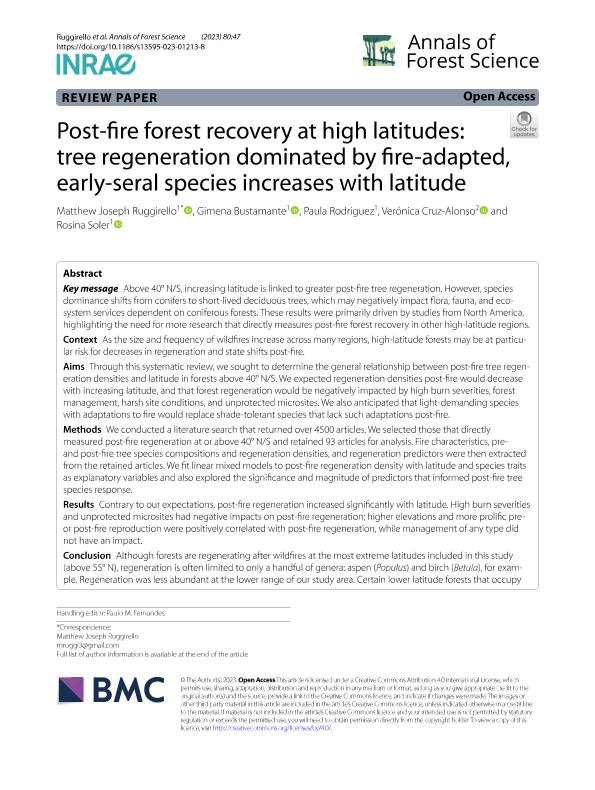Mostrar el registro sencillo del ítem
dc.contributor.author
Ruggirello, Matthew Joseph

dc.contributor.author
Bustamante, Gimena Noemi

dc.contributor.author
Rodríguez, Paula

dc.contributor.author
Cruz Alonso, Verónica
dc.contributor.author
Soler Esteban, Rosina Matilde

dc.date.available
2024-04-03T15:42:51Z
dc.date.issued
2023-12
dc.identifier.citation
Ruggirello, Matthew Joseph; Bustamante, Gimena Noemi; Rodríguez, Paula; Cruz Alonso, Verónica; Soler Esteban, Rosina Matilde; Post-fire forest recovery at high latitudes: Tree regeneration dominated by fire-adapted, early-seral species increases with latitude; BioMed Central; Annals of Forest Science; 80; 1; 12-2023; 1-30
dc.identifier.uri
http://hdl.handle.net/11336/231820
dc.description.abstract
Key message Above 40° N/S, increasing latitude is linked to greater post-fre tree regeneration. However, species dominance shifts from conifers to short-lived deciduous trees, which may negatively impact fora, fauna, and ecosystem services dependent on coniferous forests. These results were primarily driven by studies from North America, highlighting the need for more research that directly measures post-fre forest recovery in other high-latitude regions.Context As the size and frequency of wildfires increase across many regions, high-latitude forests may be at particular risk for decreases in regeneration and state shifts post-fre.Aims Through this systematic review, we sought to determine the general relationship between post-fre tree regeneration densities and latitude in forests above 40° N/S. We expected regeneration densities post-fre would decrease with increasing latitude, and that forest regeneration would be negatively impacted by high burn severities, forest management, harsh site conditions, and unprotected microsites. We also anticipated that light-demanding species with adaptations to fre would replace shade-tolerant species that lack such adaptations post-fre.Methods We conducted a literature search that returned over 4500 articles. We selected those that directly measured post-fre regeneration at or above 40° N/S and retained 93 articles for analysis. Fire characteristics, preand post-fre tree species compositions and regeneration densities, and regeneration predictors were then extracted from the retained articles. We fit linear mixed models to post-fre regeneration density with latitude and species traits as explanatory variables and also explored the significance and magnitude of predictors that informed post-fre tree species response.Results Contrary to our expectations, post-fre regeneration increased significantly with latitude. High burn severities and unprotected microsites had negative impacts on post-fre regeneration; higher elevations and more prolifc post-fre reproduction were positively correlated with post-fre regeneration, while management of any type did not have an impact.Conclusion Although forests are regenerating after wildfire at the most extreme latitudes included in this study (above 55° N), regeneration is often limited to only a handful of genera: aspen (Populus) and birch (Betula), for example. Regeneration was less abundant at the lower range of our study area. Certain lower latitude forests that occupy marginal habitats are under increasing stress from drier, warmer conditions that are exacerbated by wildfires. Results were largely driven by studies from Canada and the USA and may not be applicable to all high-latitude forests.
dc.format
application/pdf
dc.language.iso
eng
dc.publisher
BioMed Central

dc.rights
info:eu-repo/semantics/openAccess
dc.rights.uri
https://creativecommons.org/licenses/by/2.5/ar/
dc.subject
FIRE TOLERANCE
dc.subject
TREE REGENERATION
dc.subject
BOREAL
dc.subject
WILDFIRE
dc.subject.classification
Conservación de la Biodiversidad

dc.subject.classification
Ciencias Biológicas

dc.subject.classification
CIENCIAS NATURALES Y EXACTAS

dc.title
Post-fire forest recovery at high latitudes: Tree regeneration dominated by fire-adapted, early-seral species increases with latitude
dc.type
info:eu-repo/semantics/article
dc.type
info:ar-repo/semantics/artículo
dc.type
info:eu-repo/semantics/publishedVersion
dc.date.updated
2024-02-26T13:55:29Z
dc.identifier.eissn
1297-966X
dc.journal.volume
80
dc.journal.number
1
dc.journal.pagination
1-30
dc.journal.pais
Reino Unido

dc.journal.ciudad
Londres
dc.description.fil
Fil: Ruggirello, Matthew Joseph. Consejo Nacional de Investigaciones Científicas y Técnicas. Centro Austral de Investigaciones Científicas; Argentina
dc.description.fil
Fil: Bustamante, Gimena Noemi. Consejo Nacional de Investigaciones Científicas y Técnicas. Centro Austral de Investigaciones Científicas; Argentina
dc.description.fil
Fil: Rodríguez, Paula. Consejo Nacional de Investigaciones Científicas y Técnicas. Centro Austral de Investigaciones Científicas; Argentina
dc.description.fil
Fil: Cruz Alonso, Verónica. Universidad Complutense de Madrid; España
dc.description.fil
Fil: Soler Esteban, Rosina Matilde. Consejo Nacional de Investigaciones Científicas y Técnicas. Centro Austral de Investigaciones Científicas; Argentina
dc.journal.title
Annals of Forest Science
dc.relation.alternativeid
info:eu-repo/semantics/altIdentifier/url/https://annforsci.biomedcentral.com/articles/10.1186/s13595-023-01213-8
dc.relation.alternativeid
info:eu-repo/semantics/altIdentifier/doi/https://doi.org/10.1186/s13595-023-01213-8
Archivos asociados
